#aws fargate
Explore tagged Tumblr posts
Text
youtube
#youtube#video#codeonedigest#microservices#aws#microservice#docker#awscloud#aws ecs fargate tutorial#elastic container service#elasticcontainerservice#fargate#aws fargate#nodejs projects#nodejs module#nodejs express#node js#nodejs tutorial#nodejs#node js training#node js development company#node js express
0 notes
Text
Deploying ColdFusion Microservices Using AWS Fargate and ECS
#Deploying ColdFusion Microservices Using AWS Fargate and ECS#Deploying ColdFusion Microservices Using AWS Fargate#Deploying ColdFusion Microservices Using AWS ECS
0 notes
Text
Welche AWS-Services stehen für Cloud Computing zur Verfügung?: Die Überschrift lautet: "Cloud Computing mit AWS: Die verschiedenen Services im Überblick"
#CloudComputing #AWS #AmazonEC2 #AmazonS3 #AmazonRDS #AWSElasticBeanstalk #AWSLambda #AmazonRedshift #AmazonKinesis #AmazonECS #AmazonLightsail #AWSFargate Entdecken Sie die verschiedenen Services von AWS für Cloud Computing und machen Sie sich mit den Vor- und Nachteilen vertraut!
Cloud Computing ist in vielerlei Hinsicht eine revolutionäre Technologie. Es bietet Unternehmen die Möglichkeit, ihr Rechenzentrum zu einer kostengünstigen, zuverlässigen und flexiblen Infrastruktur zu machen. Mit Cloud Computing können Unternehmen auf jeder Plattform, zu jeder Zeit und an jedem Ort auf ihre Rechenzentrumsressourcen zugreifen. Amazon Web Services (AWS) ist einer der führenden…
View On WordPress
#Amazon EC2#Amazon ECS#Amazon Kinesis#Amazon Lightsail#Amazon RDS#Amazon Redshift#Amazon S3#AWS Elastic Beanstalk#AWS Fargate.#AWS Lambda
0 notes
Text
Kumologica Container Inside AWS ECS Fargate
http://securitytc.com/TFq3db
2 notes
·
View notes
Text
The Power of Amazon Web Services (AWS): A Detailed Guide for 2025
Amazon Web Services (AWS) is the leading cloud computing platform, providing a wide range of services that empower businesses to grow, innovate, and optimize operations efficiently. With an increasing demand for cloud-based solutions, AWS has become the backbone of modern enterprises, offering high-performance computing, storage, networking, and security solutions. Whether you are an IT professional, a business owner, or an aspiring cloud architect, understanding AWS can give you a competitive edge in the technology landscape.
In this blog we will guide and explore AWS fundamentals, key services, benefits, use cases, and future trends, helping you navigate the AWS ecosystem with confidence.
What is AWS?
Amazon Web Services (AWS) is a secure cloud computing platform that provides on-demand computing resources, storage, databases, machine learning, and networking solutions. AWS eliminates the need for physical infrastructure, enabling businesses to run applications and services seamlessly in a cost-effective manner.
With over 200 fully featured services, AWS powers startups, enterprises, and government organizations worldwide. Its flexibility, scalability, and pay-as-you-go pricing model make it a preferred choice for cloud adoption.
Key AWS Services You Must Know
AWS offers a vast range of services, categorized into various domains. Below are some essential AWS services that are widely used:
1. Compute Services
Amazon EC2 (Elastic Compute Cloud): Provides resizable virtual servers for running applications.
AWS Lambda: Enables serverless computing, allowing you to run code without provisioning or managing servers.
Amazon Lightsail: A simple virtual private server (VPS) for small applications and websites.
AWS Fargate: A serverless compute engine for containerized applications.
2. Storage Services
Amazon S3 (Simple Storage Service): Object storage solution for scalable data storage.
Amazon EBS (Elastic Block Store): Persistent block storage for EC2 instances.
Amazon Glacier: Low-cost archival storage for long-term data backup.
3. Database Services
Amazon RDS (Relational Database Service): Fully managed relational databases like MySQL, PostgreSQL, and SQL Server.
Amazon DynamoDB: NoSQL database for key-value and document storage.
Amazon Redshift: Data warehousing service for big data analytics.
4. Networking and Content Delivery
Amazon VPC (Virtual Private Cloud): Provides a secure and isolated network in AWS.
Amazon Route 53: Scalable domain name system (DNS) service.
AWS CloudFront: Content delivery network (CDN) for fast and secure content delivery.
5. Security and Identity Management
AWS IAM (Identity and Access Management): Provides secure access control to AWS resources.
AWS Shield: DDoS protection for applications.
AWS WAF (Web Application Firewall): Protects applications from web threats.
6. Machine Learning & AI
Amazon SageMaker: Builds, trains, and deploys machine learning models.
Amazon Rekognition: Image and video analysis using AI.
Amazon Polly: Converts text into speech using deep learning.
Benefits of Using AWS
1. Scalability and Flexibility
AWS enables businesses to scale their infrastructure dynamically, ensuring seamless performance even during peak demand periods.
2. Cost-Effectiveness
With AWS's pay-as-you-go pricing, businesses only pay for the resources they use, reducing unnecessary expenses.
3. High Availability and Reliability
AWS operates in multiple regions and availability zones, ensuring minimal downtime and high data redundancy.
4. Enhanced Security
AWS offers advanced security features, including encryption, identity management, and compliance tools, ensuring data protection.
5. Fast Deployment
With AWS, businesses can deploy applications quickly, reducing time-to-market and accelerating innovation.
Popular Use Cases of AWS
1. Web Hosting
AWS is widely used for hosting websites and applications with services like EC2, S3, and CloudFront.
2. Big Data Analytics
Enterprises leverage AWS services like Redshift and AWS Glue for data warehousing and ETL processes.
3. DevOps and CI/CD
AWS supports DevOps practices with services like AWS CodePipeline, CodeBuild, and CodeDeploy.
4. Machine Learning and AI
Organizations use AWS AI services like SageMaker for building intelligent applications.
5. IoT Applications
AWS IoT Core enables businesses to connect and manage IoT devices securely.
Future Trends in AWS and Cloud Computing
1. Serverless Computing Expansion
More businesses are adopting AWS Lambda and Fargate for running applications without managing servers.
2. Multi-Cloud and Hybrid Cloud Adoption
AWS Outposts and AWS Hybrid Cloud solutions are bridging the gap between on-premise and cloud environments.
3. AI and Machine Learning Growth
AWS continues to enhance AI capabilities, driving innovation in automation and data processing.
4. Edge Computing Development
AWS Wavelength and AWS Local Zones will expand the reach of cloud computing to edge devices.
Conclusion
Amazon Web Services (AWS) is transforming how businesses operate in the digital era, providing unmatched scalability, security, and performance. Whether you are an enterprise looking to migrate to the cloud, a developer building applications, or a data scientist leveraging AI, AWS has a solution to your needs.
By mastering AWS, you can explore new career opportunities and drive business innovation. Start your AWS journey today and explore the limitless possibilities of cloud computing.
0 notes
Text
AWS Exam Sample Questions 2025?
To effectively prepare for the AWS Certified Solutions Architect – Associate (SAA-C03) exam in 2025, follow these steps:
Understand the Exam Objectives – Review the official AWS exam guide to understand key topics.
Study with Reliable Resources – Use AWS whitepapers, documentation, and online courses.
Practice with Clearcatnet – Utilize Clearcatnet's latest practice tests to assess your knowledge and improve weak areas.
Hands-on Experience – Gain practical experience by working on AWS services in a real or simulated environment.
Review and Revise – Revisit important concepts, practice time management, and take mock tests before the exam.
By following this structured approach, you can confidently prepare and increase your chances of passing the SAA-C03 exam on your first attempt.
Which service allows you to securely connect an on-premises network to AWS?
A) AWS Direct Connect B) Amazon Route 53 C) Amazon CloudFront D) AWS Snowball
A company wants to host a web application with high availability. Which solution should they use?
A) Deploy on a single EC2 instance with an Elastic IP B) Use an Auto Scaling group across multiple Availability Zones C) Store website files on Amazon S3 and use CloudFront D) Host the application on an Amazon RDS instance
What AWS service allows you to run containerized applications without managing servers?
A) AWS Lambda B) Amazon ECS with Fargate C) Amazon RDS D) AWS Glue
Which AWS storage service provides automatic replication across multiple Availability Zones?
A) Amazon EBS B) Amazon S3 C) Amazon EC2 instance store D) AWS Snowball
How can you restrict access to an S3 bucket to only a specific VPC?
A) Use an IAM role B) Enable AWS Shield C) Use an S3 bucket policy D) Use a VPC endpoint policy
A company is designing a high-performance computing (HPC) solution using Amazon EC2 instances. The workload requires low-latency, high-bandwidth communication between instances. Which EC2 feature should the company use?
A) Placement Groups with Cluster Strategy B) Auto Scaling Groups C) EC2 Spot Instances D) Elastic Load Balancing
A company needs to store logs from multiple applications running on AWS. The logs must be available for analysis for 30 days and then automatically deleted. Which AWS service should be used?
A) Amazon S3 with a lifecycle policy B) Amazon RDS C) Amazon EFS D) Amazon EC2 instance with attached EBS volume
A company wants to run a web application in a highly available architecture using Amazon EC2 instances. The company requires automatic failover and must distribute incoming traffic across multiple instances. Which AWS service should be used?
A) AWS Auto Scaling and Application Load Balancer B) Amazon S3 and Amazon CloudFront C) AWS Lambda and API Gateway D) Amazon RDS Multi-AZ
A company is migrating a database from an on-premises data center to AWS. The database must remain online with minimal downtime during migration. Which AWS service should be used?
A) AWS Database Migration Service (DMS) B) AWS Snowball C) AWS Backup D) AWS Glue
An application running on Amazon EC2 needs to access an Amazon S3 bucket securely. What is the best practice for granting access?
A) Attach an IAM role with S3 permissions to the EC2 instance B) Store AWS access keys on the EC2 instance C) Use a security group to grant access to the S3 bucket D) Create an IAM user and share credentials with the application
For Getting More Questions and PDF Download Visit 👉 WWW.CLEARCATNET.COM
#AWS#AWSCertified#AWSCertification#AWSCloud#AWSCommunity#SAAC03#AWSExam#AWSSolutionsArchitect#AWSSAA#AWSAssociate#CloudComputing#CloudCareer#ITCertification#TechLearning#CloudEngineer#StudyTips#ExamPrep#CareerGrowth#LearnAWS#AWSJobs
0 notes
Text
AWS Modernization: Ambitiously Rejuvenating the Cloud Journey with Innovation
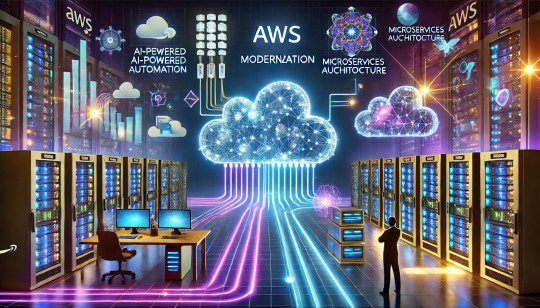
Firms are all rushing towards the cloud-basted solution due to massive demand for agility, cost-effectiveness, and innovation within this fast-paced digital epoch. AWS offers innovation solutions to modernize legacy architecture, optimize workloads and achieve operational excellence. This blog analyzes the features of some top AWS modernization services, showing how they can change the course of your cloud journey.
1. AWS Lambda
AWS Lambda is a serverless computing service that runs code without having to provision or manage servers. It scales automatically according to demand, so you can build scalable applications and reduce the infrastructure complexity.
2. Amazon ECS and EKS
Modernization of application deployment is now easier with Amazon ECS and EKS. This allows organizations to move towards containerization, has simplified application management, and assures scalability across environments.
3. AWS Fargate
AWS Fargate is a serverless compute engine for containers that eliminated the need for server management; therefore, the developers can focus on just developing apps. This not only optimizes resource use due to pay-as-you-go pricing and automatic scaling.
4. Amazon Aurora
Amazon Aurora is an extremely high-performing, resilient cloud-native relational database service that is compatible with open-source engines MySQL and PostgreSQL, making the tool ideal for any organization looking to migrate databases.
5. AWS Application Migration Service
The AWS Application Migration Service (AWS MGN) makes it easier to move applications from on-premises to AWS. It automates significant parts of the migration process and minimizes downtime.
6. AWS DevOps Tools
AWS has matured in terms of using numerous development tools, from AWS CodePipeline, AWS CodeBuild, and AWS CodeDeploy, that allow for continuous integration and continuous delivery (CI/CD), thus minimizing changes to development cycle times and effectiveness of deployment.
7. AWS Modernization Hub
The AWS Modernization Hub is a one-stop solution for the planning and execution of modernization projects. It provides insights, resources, and guidance toward fine-tuning modern architecture migration.
Utilization of AWS modernization solutions keeps organizations at the forefront, innovating ahead of time and optimizing business processes. With serverless computing, containerization, and automated migrations, AWS is the secret to your future-proof cloud. Using these very available solutions, organizations can create new avenues for growth and digital transform.
Conclusion
AWS modernization is a wholesale cleanup and not merely an upgrade in technologies for an enterprise to innovate, simplify, and expand at speed. The adoption of cloud-native architectures, serverless architectures, AI-driven automations, and DevOps practices envelop these capabilities with new levels of efficiency, security, and cost-competitiveness.
With this ambitious reimagination of the cloud experience, organizations are capable of taking the lead in the fast-paced competition of the digital world. Scaling modernization is assured with AWS tooling and frameworks, no matter if it is based on microservices, containerization, or machine learning integration.
Cloud innovation is endless. Organizations that respond nimbly and continuously update their AWS strategies will continue to prosper, taking advantage of the latest technologies in pursuing business growth and stability.
1 note
·
View note
Text
Deploying Containers on AWS ECS with Fargate
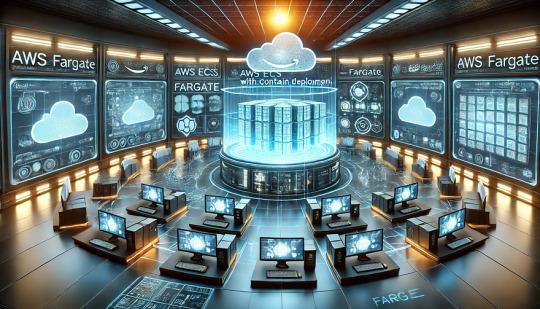
Introduction
Amazon Elastic Container Service (ECS) with AWS Fargate enables developers to deploy and manage containers without managing the underlying infrastructure. Fargate eliminates the need to provision or scale EC2 instances, providing a serverless approach to containerized applications.
This guide walks through deploying a containerized application on AWS ECS with Fargate using AWS CLI, Terraform, or the AWS Management Console.
1. Understanding AWS ECS and Fargate
✅ What is AWS ECS?
Amazon ECS (Elastic Container Service) is a fully managed container orchestration service that allows running Docker containers on AWS.
✅ What is AWS Fargate?
AWS Fargate is a serverless compute engine for ECS that removes the need to manage EC2 instances, providing:
Automatic scaling
Per-second billing
Enhanced security (isolation at the task level)
Reduced operational overhead
✅ Why Choose ECS with Fargate?
✔ No need to manage EC2 instances ✔ Pay only for the resources your containers consume ✔ Simplified networking and security ✔ Seamless integration with AWS services (CloudWatch, IAM, ALB)
2. Prerequisites
Before deploying, ensure you have:
AWS Account with permissions for ECS, Fargate, IAM, and VPC
AWS CLI installed and configured
Docker installed to build container images
An existing ECR (Elastic Container Registry) repository
3. Steps to Deploy Containers on AWS ECS with Fargate
Step 1: Create a Dockerized Application
First, create a simple Dockerfile for a Node.js or Python application.
Example: Node.js DockerfiledockerfileFROM node:16-alpine WORKDIR /app COPY package.json . RUN npm install COPY . . CMD ["node", "server.js"] EXPOSE 3000
Build and push the image to AWS ECR:shaws ecr create-repository --repository-name my-app docker build -t my-app . docker tag my-app:latest <AWS_ACCOUNT_ID>.dkr.ecr.<REGION>.amazonaws.com/my-app:latest aws ecr get-login-password --region <REGION> | docker login --username AWS --password-stdin <AWS_ACCOUNT_ID>.dkr.ecr.<REGION>.amazonaws.com docker push <AWS_ACCOUNT_ID>.dkr.ecr.<REGION>.amazonaws.com/my-app:latest
Step 2: Create an ECS Cluster
Use the AWS CLI to create a cluster:shaws ecs create-cluster --cluster-name my-cluster
Or use Terraform:hclresource "aws_ecs_cluster" "my_cluster" { name = "my-cluster" }
Step 3: Define a Task Definition for Fargate
The task definition specifies how the container runs.
Create a task-definition.js{ "family": "my-task", "networkMode": "awsvpc", "executionRoleArn": "arn:aws:iam::<AWS_ACCOUNT_ID>:role/ecsTaskExecutionRole", "cpu": "512", "memory": "1024", "requiresCompatibilities": ["FARGATE"], "containerDefinitions": [ { "name": "my-container", "image": "<AWS_ACCOUNT_ID>.dkr.ecr.<REGION>.amazonaws.com/my-app:latest", "portMappings": [{"containerPort": 3000, "hostPort": 3000}], "essential": true } ] }
Register the task definition:shaws ecs register-task-definition --cli-input-json file://task-definition.json
Step 4: Create an ECS Service
Use AWS CLI:shaws ecs create-service --cluster my-cluster --service-name my-service --task-definition my-task --desired-count 1 --launch-type FARGATE --network-configuration "awsvpcConfiguration={subnets=[subnet-xyz],securityGroups=[sg-xyz],assignPublicIp=\"ENABLED\"}"
Or Terraform:hclresource "aws_ecs_service" "my_service" { name = "my-service" cluster = aws_ecs_cluster.my_cluster.id task_definition = aws_ecs_task_definition.my_task.arn desired_count = 1 launch_type = "FARGATE" network_configuration { subnets = ["subnet-xyz"] security_groups = ["sg-xyz"] assign_public_ip = true } }
Step 5: Configure a Load Balancer (Optional)
If the service needs internet access, configure an Application Load Balancer (ALB).
Create an ALB in your VPC.
Add an ECS service to the target group.
Configure a listener rule for routing traffic.
4. Monitoring & Scaling
🔹 Monitor ECS Service
Use AWS CloudWatch to monitor logs and performance.shaws logs describe-log-groups
🔹 Auto Scaling ECS Tasks
Configure an Auto Scaling Policy:sh aws application-autoscaling register-scalable-target \ --service-namespace ecs \ --scalable-dimension ecs:service:DesiredCount \ --resource-id service/my-cluster/my-service \ --min-capacity 1 \ --max-capacity 5
5. Cleaning Up Resources
After testing, clean up resources to avoid unnecessary charges.shaws ecs delete-service --cluster my-cluster --service my-service --force aws ecs delete-cluster --cluster my-cluster aws ecr delete-repository --repository-name my-app --force
Conclusion
AWS ECS with Fargate simplifies container deployment by eliminating the need to manage servers. By following this guide, you can deploy scalable, cost-efficient, and secure applications using serverless containers.
WEBSITE: https://www.ficusoft.in/aws-training-in-chennai/
0 notes
Text
Exploring Amazon ECS: A Comprehensive Guide to AWS's Container Management Service
Amazon Elastic Container Service (ECS) is a powerful and flexible container orchestration service offered by Amazon Web Services (AWS). Designed for developers and organizations looking to deploy and manage containerized applications, ECS simplifies the orchestration process. In this blog, we'll explore the features, benefits, and best practices of using Amazon ECS.
If you want to advance your career at the AWS Course in Pune, you need to take a systematic approach and join up for a course that best suits your interests and will greatly expand your learning path.
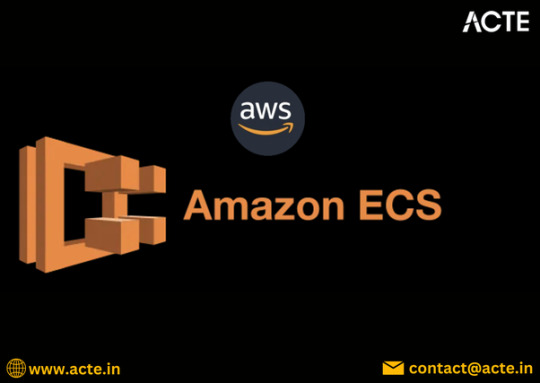
What is Amazon ECS?
Amazon ECS allows you to run Docker containers on a managed cluster of Amazon EC2 instances. It abstracts the complexity of infrastructure management, enabling you to focus on building and deploying applications. With ECS, you can easily manage the lifecycle of your containers, scale applications based on demand, and integrate with other AWS services.
Key Features of Amazon ECS
1. Task Definitions
Task definitions are a crucial component of ECS. They define the parameters for your containers, including the Docker image to use, CPU and memory requirements, networking settings, and environment variables. This makes it easy to deploy consistent and repeatable container instances.
2. Service Management
ECS allows you to define services that maintain a specified number of task instances running at all times. If a task fails, ECS automatically replaces it, ensuring high availability for your applications.
3. Integration with AWS Services
ECS seamlessly integrates with other AWS services, such as Amazon RDS, Amazon S3, and AWS Lambda. This integration helps you build complex applications that leverage the full power of the AWS ecosystem.
4. Scalability and Load Balancing
ECS supports auto-scaling, allowing you to adjust the number of running tasks based on application demand. You can set up policies that scale your services in or out automatically, ensuring optimal performance while minimizing costs.
5. Security Features
ECS provides robust security controls, including IAM roles for fine-grained access management, VPC support for network isolation, and encryption options for sensitive data. This helps you maintain compliance and protect your applications.
6. Support for Fargate
AWS Fargate is a serverless compute engine for running containers. With Fargate, you can run ECS tasks without managing the underlying EC2 instances, simplifying deployment and scaling further.
To master the intricacies of AWS and unlock its full potential, individuals can benefit from enrolling in the AWS Online Training.
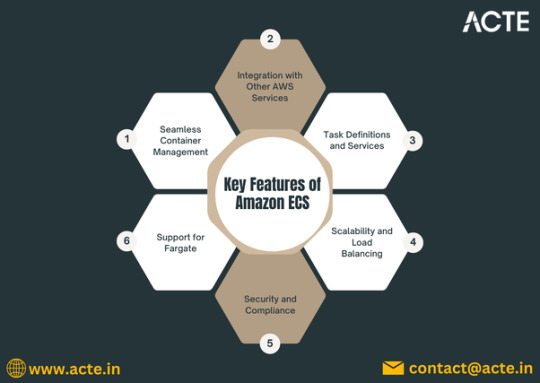
Benefits of Using Amazon ECS
Cost Efficiency: With ECS, you only pay for the resources you use, reducing infrastructure costs. Fargate eliminates the need for provisioning EC2 instances, allowing for more flexible billing.
High Availability: ECS is built for resilience. Its automatic health checks and self-healing capabilities ensure your applications remain available even in the face of failures.
Flexibility in Deployment: You can choose to run your containers on EC2 instances or use Fargate, giving you the flexibility to select the best deployment model for your needs.
Best Practices for Using Amazon ECS
Use Task Definitions Wisely: Create reusable task definitions to minimize duplication and ensure consistency across environments.
Implement Auto-Scaling: Set up auto-scaling policies based on metrics such as CPU utilization or request count to optimize resource usage.
Leverage IAM for Security: Use IAM roles to define permissions for your tasks, ensuring that your applications have access to only the resources they need.
Monitor and Log: Utilize AWS CloudWatch for monitoring and logging your ECS services. This will help you identify performance bottlenecks and troubleshoot issues.
Test Before Production: Always test your applications in a staging environment before deploying to production. This helps catch issues early and ensures a smooth rollout.
Conclusion
Amazon ECS is a robust solution for managing containerized applications in the cloud. With its rich feature set, seamless integration with AWS services, and support for both EC2 and Fargate, ECS provides the tools necessary to build, deploy, and scale applications efficiently. By understanding its capabilities and following best practices, you can harness the full potential of Amazon ECS to enhance your application development and deployment processes.
0 notes
Text
How Kubernetes Facilitates the Orchestration of Containers in AWS
Containerization has transformed the design, deployment, and scaling of cloud applications. With k8s (Kubernetes), it is possible to be efficient when dealing with thousands of containers at scale. In AWS, Kubernetes proves crucial in providing benefits such as scalability, streamlined operations, and simplification of maintenance for organizations. In this blog, I’ll share insights on how Kubernetes aids container orchestration in AWS, its benefits, and ways to leverage it for building robust applications—a journey inspired by my foundational learning from the cloud computing course online at ACTE Institute.

Understanding Container Orchestration
Before getting into Kubernetes, it is important to understand container orchestration. It is the process of managing multiple containers for applications in distributed environments, automating tasks such as deployment, scaling, load balancing, and networking. Managing numerous containers in cloud environments like AWS is challenging, especially at scale, and that's where Kubernetes excels. Kubernetes, also known as K8s, is an open-source system designed to automate the deployment, scaling, and management of containerized applications. Initially developed by Google, Kubernetes has become the industry standard for container orchestration. Its ability to abstract complex tasks makes it an indispensable tool for developers and organizations.
Features of Kubernetes
Kubernetes offers numerous features, including:
Automated Scheduling: Efficiently assigns containers to nodes based on resource availability.
Self-Healing Mechanisms: Automatically restarts or replaces failed containers.
Load Balancing: Distributes traffic to ensure optimal performance.
Service Discovery: It enables seamless communication between microservices.
Horizontal Scaling: Dynamically adjusts container instances to match demand.
Rolling Updates and Rollbacks: Supports smooth application updates without downtime.
All this makes Kubernetes an ideal choice for managing containerized applications in dynamic and scalable environments like AWS.
Kubernetes on AWS: How It Works
There are two primary ways of running Kubernetes on AWS:
Amazon EKS (Elastic Kubernetes Service):
Amazon EKS is a managed service, which makes running Kubernetes clusters on AWS easier. Here's why it's in demand:
Managed Control Plane: AWS operates the Kubernetes control plane, taking away operational burdens.
Integration: Works natively with services like EC2, S3, IAM, and CloudWatch, making deployment and management easy and efficient.
Self-managed Kubernetes on EC2:
Organizations can set up Kubernetes manually on EC2 instances for better control. This is suitable for those who require a custom configuration but will incur more maintenance responsibility.
Advantages of Using Kubernetes in AWS
Scalability and Flexibility: Kubernetes supports horizontal scaling, meaning that container instances can be easily scaled up or down according to demand. AWS Auto Scaling helps to complement this by dynamically managing the resources in EC2.
For instance, on Black Friday, a retail application running on Kubernetes in AWS scaled up automatically to match the surge in traffic and continued serving the users uninterrupted.
High Availability and Fault Tolerance: Kubernetes makes sure that the applications stay available through its self-recovery capability. Through the deployment of clusters across several AWS Availability Zones, the applications stay resilient even while infrastructure fails.
Automated Deployment and Management: Kubernetes is highly compatible with CI/CD pipelines, which automate the deployment of applications. Rolling updates and rollbacks ensure smooth upgrades without downtime.
Cost Optimization: Kubernetes's integration with AWS Fargate allows for serverless compute, reducing the cost of infrastructure management. Using AWS spot instances also reduces EC2 costs by a significant amount.
Improved Security: The security features of Kubernetes combined with AWS tools ensure robust protection for containerized applications.

Integrating Kubernetes with AWS Services
AWS services enhance Kubernetes’s capabilities. Here are notable integrations:
Amazon RDS: Provides managed relational databases for Kubernetes applications.
Amazon S3: Offers scalable storage, accessible via Kubernetes with Elastic File System
(EFS) or Elastic Block Store (EBS).
AWS CloudWatch: Monitors Kubernetes clusters and applications, providing actionable insights.
AWS Load Balancer: Handles traffic distribution for Kubernetes applications automatically.
Kubernetes Across Other Cloud Platforms
Kubernetes isn’t exclusive to AWS. It’s widely used in:
Google Cloud Kubernetes (GKE): Provides a deep integration with Google's cloud ecosystem.
Azure Kubernetes Service (AKS): Makes it easier to deploy Kubernetes on Microsoft Azure.
Openshift Kubernetes: Merges Kubernetes with more enterprise features.
Monitoring Kubernetes with Prometheus : Prometheus is a powerful monitoring tool for Kubernetes clusters. The Kube Prometheus Stack provides dashboards and alerts, which enables proactive issue resolution. Combining Prometheus with AWS CloudWatch offers comprehensive visibility into system performance.
Conclusion
Learning Kubernetes transformed my career as a solution architect. From scalable application deployment to cost optimization, Kubernetes has become the bedrock of modern cloud computing. It all started from the cloud computing course in Bangalore at ACTE Institute, building a solid foundation in cloud technologies. Today, using Kubernetes on AWS, I help organizations design resilient and efficient systems-a testament to the power of continuous learning and innovation.
0 notes
Text
Mastering DevOps with GitLab CI/CD, Docker, and AWS Fargate
Table of Contents Project Overview Technology Stack Architecture Diagram Step 1: Prerequisites Step 2: Configuring GitLab as Version Control Step 3: Preparing AWS Resources Step 4: Building and Pushing the Docker Image Step 5: Setting Up Amazon ECS with Fargate Step 6: Creating the GitLab CI/CD Pipeline Step 7: Adding Monitoring with AWS CloudWatch Conclusion Author In today’s…
0 notes
Video
youtube
(via AWS Fargate Serverless Compute Service Tutorial for Amazon Cloud Developers) Full Video Link - https://www.youtube.com/shorts/e1kMx8MOQ8kCheck out the latest technology video on CodeOneDigest's YouTube channel! A new video tutorial on AWS Fargate serverless compute service has just been published. Learn all about AWS Fargate by watching this video. #video #tutorial #aws #fargate #awsfargate #codeonedigest #youtube@java @awscloud @AWSCloudIndia @YouTube #youtube @codeonedigest #codeonedigest #aws #amazonwebservices #aws #awscloud #aws #awstutorial #awscloud #aws #amazonwebservices #cloudcomputing #awscloud #awstutorial #awstraining #awsfargate #awsfargatetutorial #awsfargatedemo #awsecsfargatetutorial #awsecsfargate #awsecsfargatedeployment #awsfargateserverless #awsserverlessfargate #awsfargateservice #serverlessfargate #serverlesscomputing #fargateaws #fargateawstutorial #amazonfargate #amazonfargatetutorial #fargateservice #fargatedockercompose #awscloudcomputing #awsfargateexplained
1 note
·
View note
Text
What Are the Benefits of Running ColdFusion on AWS Fargate?
#What Are the Benefits of Running ColdFusion on AWS Fargate?#Benefits of Running ColdFusion on AWS Fargate
0 notes
Text
How is AWS Graviton Redefining Cloud Performance and Cost Efficiency for Business Leaders?

With over 90% of businesses migrating to the cloud, the demand for cost-efficient and scalable cloud solutions has never been more critical to staying competitive. AWS Graviton, an ARM-based processor developed by AWS, is transforming cloud computing with its focus on delivering high performance at reduced costs. Designed to meet the demands of modern workloads, AWS Graviton empowers businesses to optimise resource usage without compromising efficiency.
This blog will explore the unique benefits of AWS Graviton, its role in transforming cloud strategies, and how AWS Cloud Services amplifies its impact on decision-makers and tech leaders.
I. What is AWS Graviton?
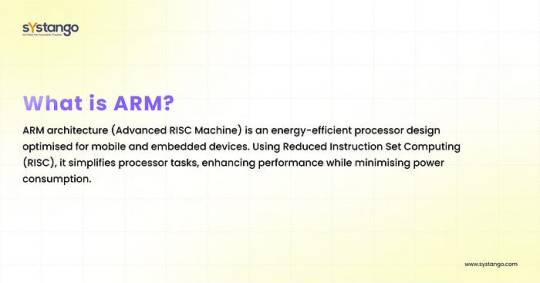
II. AWS Graviton: Features, Business Benefits, and Industry Use Cases
AWS Graviton processors combine cutting-edge technology with significant business advantages, making them a transformative tool for modern enterprises. Below is an overview of key features, the associated business benefits, and real-world examples showcasing their impact.
1. Strong Performance
Feature Details
Graviton processors, built on ARM architecture, deliver exceptional computational power across diverse workloads such as machine learning (ML), media processing, and microservices.
Business Benefits
Faster execution times for applications, improving user satisfaction.
Enhanced responsiveness during high-demand periods, ensuring business continuity.
Example
Lyft utilised Graviton2 instances to optimise the performance of its ride-hailing services. This resulted in reduced processing delays during peak hours, ensuring seamless ride-matching and better user experiences.
2. Cost Optimisation
Feature Details
Graviton-powered EC2 instances are priced 20–40% lower than traditional x86-based options, offering comparable or better performance.
Business Benefits
Reduced operational costs, enabling reinvestment in innovation.
Improved financial flexibility for startups and cost-sensitive businesses.
Example
Snap Inc. saved up to 40% in cloud expenses by migrating to Graviton2 instances while maintaining robust application performance for Snapchat’s millions of users.
3. Energy Efficiency
Feature Details
Graviton processors consume less energy due to their optimised ARM design, supporting businesses’ sustainability initiatives.
Business Benefits
Lower power consumption reduces utility costs.
Alignment with ESG goals, enhancing brand reputation and stakeholder trust.
Example
Netflix deployed Graviton instances for its video streaming workloads, cutting energy use and advancing its carbon-neutral goals without compromising streaming quality.
4. Flexibility and Scalability
Feature Details
Graviton integrates seamlessly with AWS services like Lambda, EC2, and Fargate, enabling efficient scaling for diverse workload demands.
Business Benefits
Easy adaptation to fluctuating workloads, reducing downtime risks.
Flexibility to innovate with serverless applications and global-scale platforms.
Example
Intuit scaled its QuickBooks platform during tax season using Graviton-based instances, handling increased traffic while maintaining smooth user experiences.
5. Advanced Security and Compatibility
Feature Details
Graviton processors include hardware-based protections against vulnerabilities and are compatible with widely used frameworks like MySQL, PostgreSQL, and Apache Spark.
Business Benefits
Enhanced security ensures compliance with industry standards, particularly in regulated sectors.
Smooth migration paths for existing workloads without the need for extensive rewrites.
Example
Redis Labs leveraged Graviton instances to secure database queries while improving client analytics response times, benefiting industries with real-time data needs.
6. Optimised for ML Workloads
Feature Details
Graviton offers a better price-to-performance ratio for ML model training and inference, enabling faster development cycles.
Business Benefits
Cost-effective scaling of AI/ML applications.
Shorter time-to-market for AI-driven innovations.
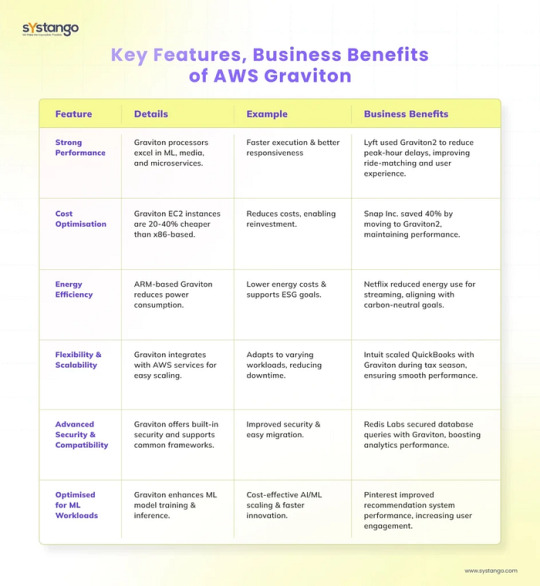
Example
Pinterest used Graviton2 instances to boost its recommendation systems, resulting in improved user engagement and personalisation for its platform.
Here’s a quick summary for decision-makers:
Business Takeaway
AWS Graviton provides a compelling combination of performance, cost efficiency, and sustainability, making it a preferred choice for businesses across industries. By adopting Graviton, enterprises can achieve operational excellence, enhance customer satisfaction, and meet sustainability goals.
III. AWS Graviton vs Intel: A Quick Comparison
Comparing AWS Graviton with Intel-based instances provides a clearer perspective for decision-makers:
Cost Efficiency: AWS Graviton instances offer 20–40% cost savings, making them a preferred choice for cloud-native workloads.
Performance: Graviton delivers up to 40% better performance for compute-intensive tasks like machine learning, while Intel shines in legacy applications needing x86 architecture.
Compatibility: Intel processors have extensive software support, but Graviton’s ARM-based architecture is optimised for modern, scalable workloads.
Energy Efficiency: AWS Graviton outperforms Intel in power efficiency, aligning with businesses focused on sustainable practices.
This comparison highlights AWS Graviton as the future-ready option for businesses seeking cost and energy efficiency while modernising their infrastructure.
IV. AWS Graviton in the Bigger AWS Ecosystem
AWS Graviton is not just a processor; it’s a vital component of the larger AWS Cloud Services ecosystem, empowering businesses to achieve operational excellence across computing, storage, and networking. Its integration capabilities make it a cornerstone of modern cloud strategies.
To read full blog visit — https://www.systango.com/blog/how-is-aws-graviton-redefining-cloud-performance-and-cost-efficiency-for-business-leaders
0 notes
Text
Deploying a Microservices Architecture with AWS ECS and Fargate
Introduction Deploying a Microservices Architecture with AWS ECS and Fargate is a crucial step in modernizing your application architecture. This tutorial will guide you through the process of deploying a microservices architecture using Amazon Elastic Container Service (ECS) and Amazon Fargate. By the end of this tutorial, you will have a comprehensive understanding of how to deploy a…
0 notes
Text
App Dev - Java_only on W2
Title: App Dev – Java – Mid Location: McLean, VA Languages Java, Spring/Spring Boot, Python, GraphQL, and Gradle… Orchestration Docker, AWS (ECS Lambda, Fargate, CloudWatch) Required Skills : Must Have – Java with Spring/Spring Boot – Python… Apply Now
0 notes